
When it comes to online advertising, Twitter for schools is often left out of the conversation.
Yes, it’s true that Twitter Ads don’t have nearly the reach of Facebook or Google Ads, but that very fact can actually be beneficial for schools. After all, Twitter Ads offer granular targeting options, and you only pay pennies when someone clicks on your ad.
While Twitter Ads alone may not generate the recruitment results you’re looking for, combined with other advertising channels, these ads provide a low-cost method of reaching key prospects on social media.
Thinking about adding Twitter Ads to your advertising mix? Read on to discover all you need to know!

Should Twitter Ads Be Part of Your Education Advertising Strategy?
If a digital marketing tactic doesn’t generate much buzz online, it’s usually either a flop or a hidden gem. While you’ll find lots of people championing Facebook, Google, and even LinkedIn Ads online, Twitter Ads don’t cause the same sort of commotion.
So what’s the verdict on Twitter ads for schools?
On a positive note, Twitter Ads are undoubtedly cost-effective. While some channels like LinkedIn make you pay a premium upfront, Twitter only charges you when you meet your advertising objective, and the price you’ll pay is bound to be lower than more expensive options like Instagram and LinkedIn.
In terms of targeting, as you may learn during advertising on Twitter online courses, Twitter may not have as many interest-based options as Facebook, but its keyword targeting capabilities are certainly more robust. You can target your Twitter ads to prospects that have used a specific word, phrase, or hashtag in their tweets – or have interacted with such posts.
Twitter also makes it easy to target specific prospective students on the platform. Although Facebook offers custom audience targeting, you’ll need your prospects’ email addresses or phone numbers to do so – whereas, with Twitter, all you’ll need is their public username.
However, one area where Facebook does outclass Twitter is in ad engagement. Rival IQ’s Social Media Industry Benchmark Report states that Facebook’s median engagement rate is 0.16%, while Twitter’s is only 0.046%.
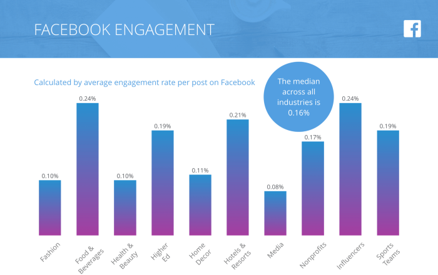
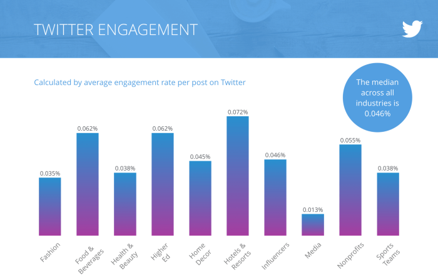
Source: Rival IQ
Since Twitter is a fast-paced platform, the lifespan of a tweet is relatively shorter than that of other social media posts. As a result, it’s easier for your ad to get lost in the noise and more difficult for you to generate the engagement you want.
Another area where Twitter Ads fall short is reach. With 1.15 billion active users on Facebook and 1 billion on Instagram, Twitter pales in comparison at 232 million active users, meaning that your pool of prospective students is likely a lot smaller on the platform.
With all that being said, is using Twitter for schools worth investing in?
If the bulk of your advertising strategy is Twitter Ads, you’re unlikely to reach your recruitment targets. However, if your school runs campaigns on other major online ad platforms, Twitter campaigns can be a great supplement to your strategy.
Setting Your School’s Twitter Ads Objectives
Digital marketing is deliberate, meaning that you should always set goals before setting up a new marketing tactic. That way, you can ensure that each component of your strategy contributes to your school’s overall student recruitment success.
Fortunately, Twitter holds you accountable to this by asking you to select a marketing objective before launching your ads. When you go to create a Twitter ad campaign, you’ll be prompted to choose one of the following objectives:
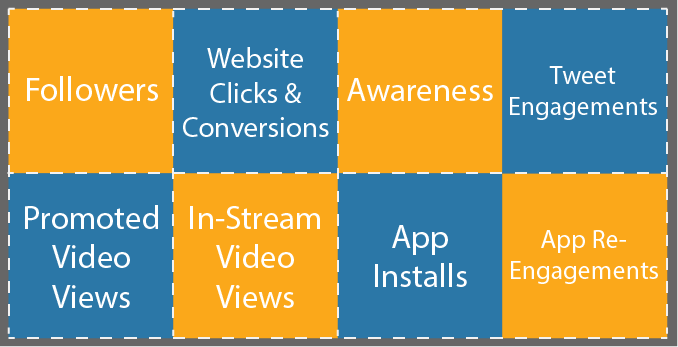
- Followers: With this objective, you’ll build a stronger Twitter presence, and will be billed for each follower.
- Website Clicks & Conversions: If you want to drive traffic to a particular webpage, consider this metric. You can choose to be charged each time someone clicks on your ad, or when they convert on your landing page. You will need to install Twitter’s conversion tracking pixel to choose the latter option.
- Awareness: If visibility is most important to you on Twitter, consider this awareness-based metric whereby you pay your bid amount every time your ad receives 1,000 impressions.
- Tweet Engagements: With this marketing objective, you’ll be charged for every like, reply, and retweet your ad generates. If you want to engage with your prospective students online, this metric is for you.
- Promoted Video Views: This metric will help maximize your video’s visibility on Twitter. In return, you’ll be charged per video view.
- In-stream Video Views: Not only can you create video ads on Twitter in Tweet form – but you can also pay to have a short video ad play at the start of videos from Twitter’s premium content partners. In both cases, you’ll be billed for each view.
- App Installs: If your school has an app and wants to promote it on Twitter, you’ll be charged each time someone installs it.
- App Re-engagements: This metric is similar to the objective above, but in this case, you only pay when people actually open and use your app.
Think carefully about which marketing objective to go with, as your choice will influence what kind of ads you’ll need to create and how much you’ll be paying.
Schools whose primary focus is on generating more inquiries and applications will likely want to choose the Website Conversions objective, as you’ll only be charged when a lead converts on one of your landing pages. If you want to build awareness or strengthen your Twitter presence, then Followers, Awareness, or Tweet Engagements may be right for your school. If you want to take advantage of the video content hype, then Promoted Video Views or In-stream Video Views would be appropriate.
Build Your Ad Groups and Begin the Bidding Process
After you’ve set your objective, you can start setting up the building blocks for your Twitter Ads campaign.
If you’ve used Google Ads before, this process will be a breeze. Both Twitter and Google use a similar ad structure, whereby you have an overarching campaign with multiple ad groups and ad creative within it:

As the structure suggests, schools will first start by defining their campaign name, budget, and duration:

Schools can then set up their ad groups. If you want, you can set a specific time period and/or budget for each of them:
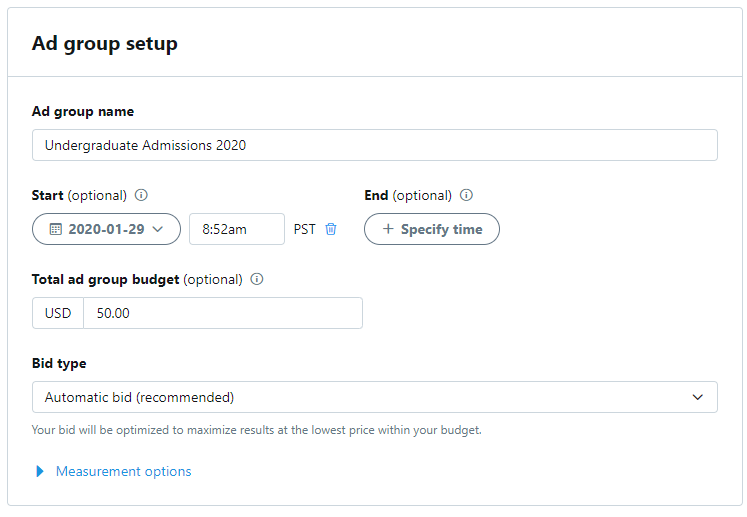
To create additional groups, click Copy ad group in the Bid type section. A new section will automatically appear in the campaign hierarchy on the left-hand side of your screen:
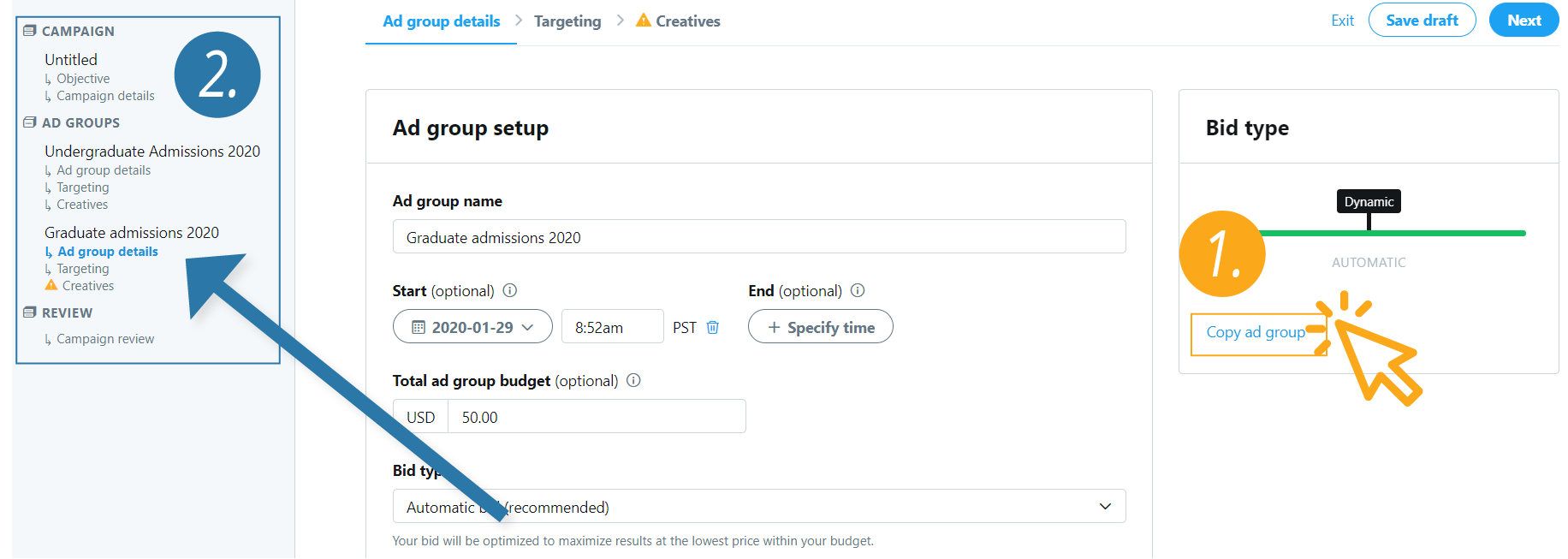
At this stage, you’ll also take care of the bidding. There are two types of bids to choose from: an automatic bid, whereby Twitter settles your bids for you, and a maximum bid, which allows you to set a price that you won’t go over.
The first bid type requires little effort on your part, but even if you choose the second option, Twitter will help you determine your maximum bid by showing you a ‘recommended range’ in the Bid type section based on what others are spending:

Targeting Your Prospective Students with Twitter Ads
The next step in the Twitter ad creation process is targeting – and it’s one you’ll want to make sure to spend ample time on.
Twitter offers standard demographic targeting options – including age, gender, and location – along with more niche parameters such as language, what device they access Twitter on, and more:
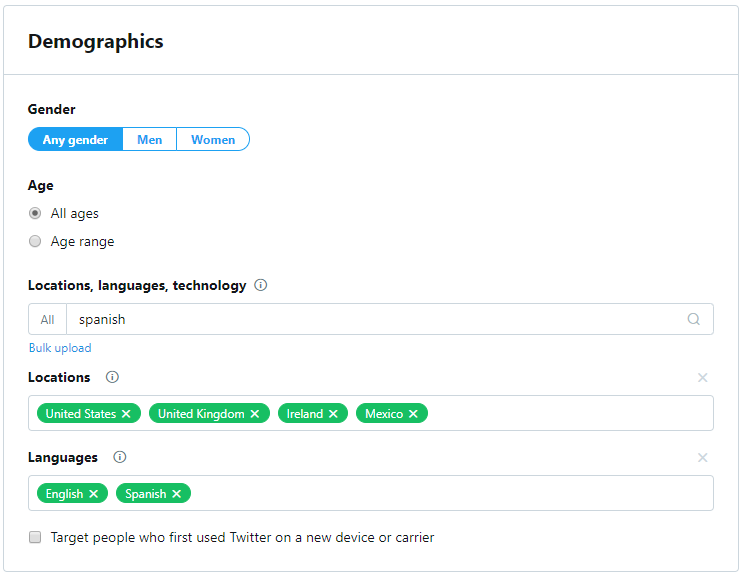
After you’ve set these parameters, click ‘Next,’ and you’ll be brought to the Audience features menu, which gets into the nitty-gritty targeting options. Here, you can select specific keywords, interests, and conversation topics – amongst other factors – to help your school reach its prospective students:
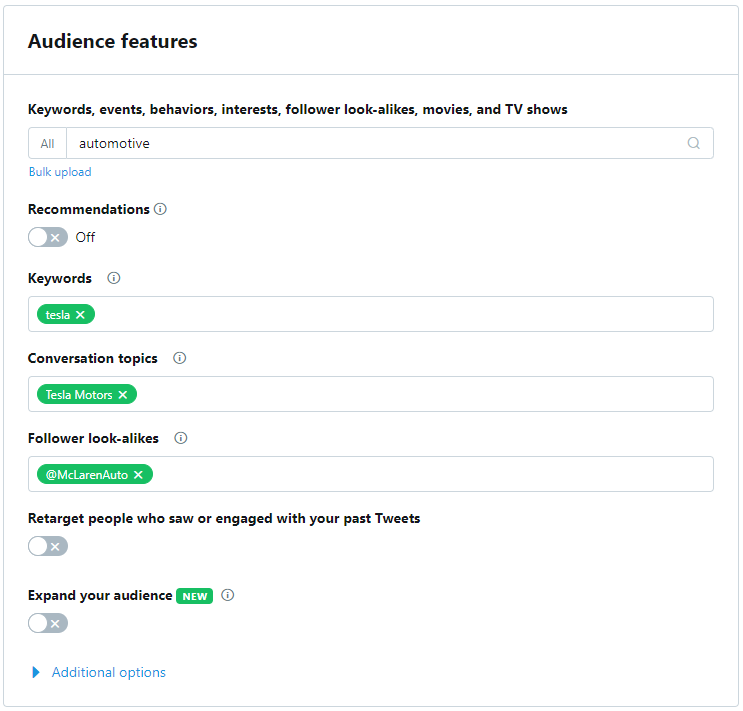
These targeting parameters are particularly useful if you can leverage major events and trends to find key prospects. If you’re a university looking to recruit tech-savvy students, you could consider creating a Twitter Ad campaign amid a major technological development that focuses on a specific conversation topic. When it comes time for high school students to apply to college, you may also want to target an admissions-related hashtag that’s used by those discussing their higher ed options on Twitter.
Additionally, you can further specify your audience by uploading a list of people you want to reach, targeting users similar to your follower base, or even retargeting prospects who’ve engaged with your Tweets.
As you set these parameters, the Audience Summary on the right-hand side of Twitter’s ad builder will update accordingly to give you a visual depiction of how many people you’re reaching:
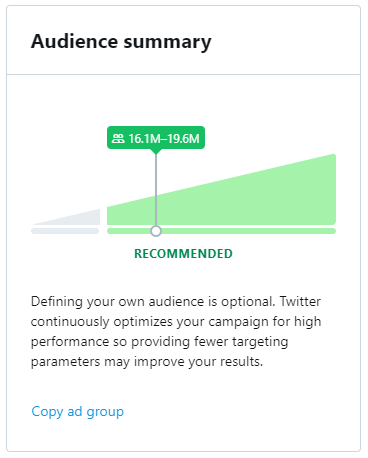
As the above image states, Twitter will optimize your campaign for you, targeting those who’ve demonstrated interest in your ad. As a result, defining your audience is optional with Twitter Ads – but it’s still a highly recommended practice for schools that want to reach a specific recruitment goal. After all, there’s no one that knows your prospective student base better than you do.
Creating Winning Twitter Ads for Schools
Once you’ve settled the technical parts of the ad creation process, you can move onto the more creative aspects.
On most social media platforms, the ad creative process is relatively straightforward: you choose your ad placement and customize the copy, images, call to action (CTA), and/or video. Twitter, however, is a tad different. The platform offers three different ad placements, and the process of creating each of these ads differs. It’s important to be well-versed in these format options if you want to build a successful campaign advertising to college students on twitter.
Twitter Ad Placements
Unlike Facebook, which offers a wide variety of ad placements, Twitter sticks to the following three formats: promoted trends, promoted accounts, and promoted tweets. Here’s where the various ads are shown on any given Twitter home screen:

The most popular ad format by far is the Promoted Tweet, because you can use a combination of video, text, and images to get your message across. They also direct users to your website and invite engagement through likes, replies, and retweets.
If you’ve seen Facebook newsfeed ads or LinkedIn Sponsored Content, you may be thinking that these Twitter Ads look relatively similar. However, the process of creating these ads differs from that of LinkedIn or Facebook.
While Facebook and LinkedIn allow advertisers to create specific copy and upload select images and videos for the ads, Twitter only allows you to use past posts as promoted Tweets:
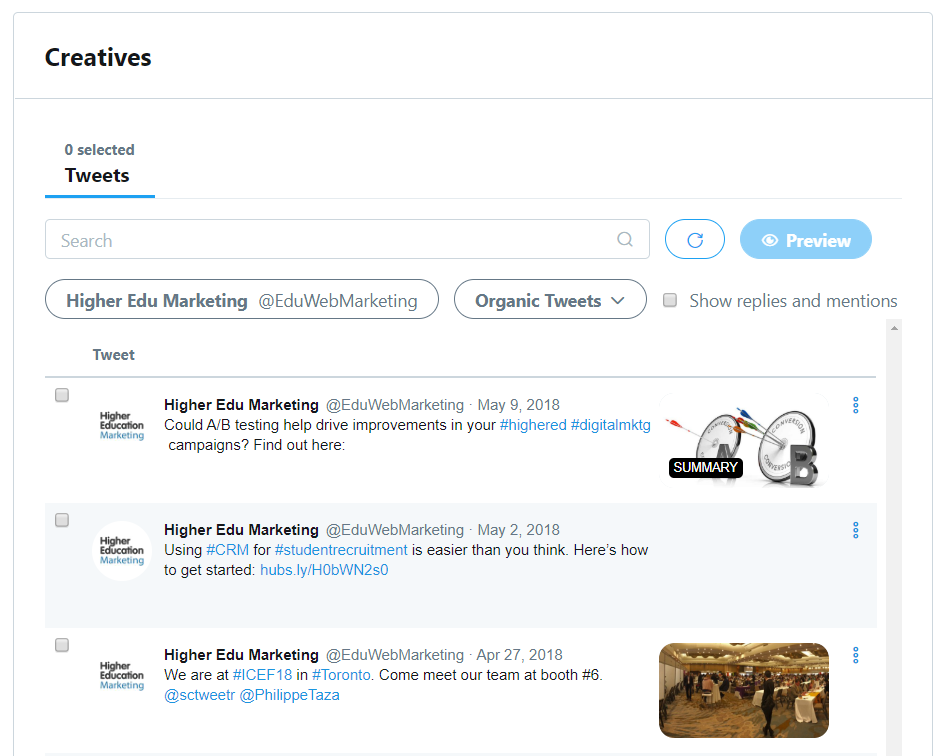
Once you’ve selected your Tweet, you can click ‘Preview” to see what your ad would look like on different devices:

As you can imagine, creating an ad out of past Tweets makes the ad creative process a whole lot easier. However, the lack of customization may frustrate schools that have a sophisticated social media strategy and don’t want to have to create certain tweets just to be able to create an ad.
The ‘Promoted Account’ requires even less effort on the part of the advertiser. Since all that’s shown in the Who to follow section is your school’s name, Twitter handle, and bio, there is no creative element involved. As such, this ad placement is only recommended for schools that want to boost their Twitter visibility, as you can’t broadcast a specific message.
Last but not least is the ‘Promoted Trends’ option. This type of ad isn’t something that schools create on the fly. You must first reach out to your Twitter account manager to get approval. Then you can begin creating your trending topic – but make sure it meets Twitter’s extensive guidelines and is under 20 characters.
While this placement option can afford your school massive exposure, it comes with an accordingly grand cost. As a result, this ad placement is most likely only feasible for large universities, and even they may baulk at the cost.
Twitter for Schools Ad Best Practices
While ‘Promoted trends’ and ‘Promoted Accounts’ require little in terms of ad creative, you’ll have to spend a fair deal of time planning out which posts to use if you go with the ‘Promoted Tweets’ ad option.
Since Twitter is a fast-paced online community, it’s important that your ads get your school’s message out as quickly and concisely as possible. After all, the word limit on a Tweet is a fraction of that of Facebook or Instagram posts, and Twitter users may scroll past anything that looks too lengthy.
Example: These promoted Tweets from the University of Miami catch the eye of prospective students with a fun gif. In addition, notice how the call to action is a simple, concise statement.

Source: Nanigans
As you can see in the above image, the University of Miami promoted four tweets with identical copy and similar design as part of their ad campaign. If you’re new to Twitter Ads, however, you may want to experiment by promoting a variety of tweets to see which generate the results you want.
Example: These two tweets from Inlingua Edinburgh could be great options for Promoted Tweets. The first tweet draws in students by offering an attractive discount, foregrounded in both the text and the image. Urgency is also emphasized with the phrase “It’s not too late.” The second tweet takes a more subtle approach, using relatively little text to let the promotional video shine.


One other thing to keep in mind when choosing which Tweets to promote is the hashtag. While schools should generally include hashtags in their Twitter posts, they are not recommended for Promoted Tweets.
Since most schools want to drive website traffic through Twitter ads, adding a hashtag gives prospects something else to click on that will direct them away from your school’s site and towards unrelated content.
Additionally, the motive behind using hashtags is boosting visibility – which is something you won’t have to worry about when you’re paying to promote your tweet.
Quick Promote
If the process of creating an ad and setting it up seems too arduous for the role that Twitter Ads play in your education marketing strategy, you may want to consider Twitter’s “Quick Promote” option.
With Quick Promote, all you have to do is choose a pre-existing tweet, click ‘Promote this Tweet,’ decide which locations you want to target, and select your budget. Since Quick Promote doesn’t use the same builder as the regular Twitter ads, the limited number of options you have makes it much easier and quicker to create ads.
Twitter recommends using Quick Promote for when you’re on the go or want to boost your Twitter visibility for little effort. As you can imagine, the results won’t necessarily be stellar, but at least the campaign won’t take too long to set up.
Twitter for Schools: Monitoring Your Ads
Just like any digital marketing tactic, Twitter Ads require careful monitoring. It’s the only way to find out what works, what doesn’t, and what you’ll need to do to improve future campaigns.
Twitter’s ad centre offers a fairly comprehensive dashboard that shows you key ad metrics such as impressions, results (based on objectives), engagement rate, cost per result, and conversions. You can also see how much you’ve spent on your campaign and how many impressions you’ve generated as a result:
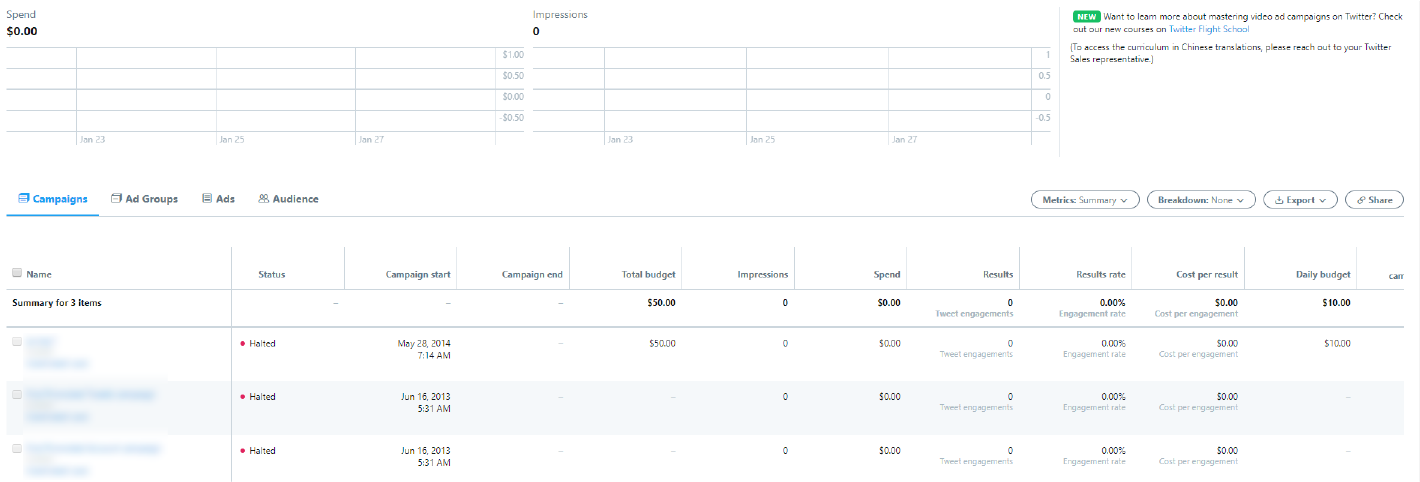
You can also customize the date range of this report, change the metrics you want to measure, and view performance by campaigns, ad groups, ads, or audience.
If you want to keep a close eye on key statistics, then you’ll find the Twitter Ads dashboard sufficient. But if you want more in-depth info – after all, the more detailed the data, the better the monitoring – or are looking to consolidate all your ad reports on a single platform, then you may want to integrate your Twitter Ad campaigns with another platform such as Google Analytics or a CRM.
One major benefit of this option is the ability to assess the overall role your Twitter ads play in your student recruitment efforts. That way, you can adjust the amount of your advertising budget that you allocate to Twitter accordingly.
Another advantage of using a CRM, in particular, is that you can create segments based on the leads you’ve generated from your Twitter Ads in order to assess the quality of prospective students you’ve found on the platform.
Example: In Mautic, HEM’s customized CRM for the education sector, you can create contact segments with a wide variety of parameters such as their characteristics, what stage in the admissions funnel they’re at, and of course, what digital marketing channel they came from.

There are a number of ways to use Twitter for schools. Although it isn’t a widely discussed option, it’s a relatively simple way to boost your visibility on the platform and reach key prospective students. Given the relatively low cost, it’s certainly worth experimenting with – if you’re prepared to pay close attention to your ad performance and optimize accordingly.






